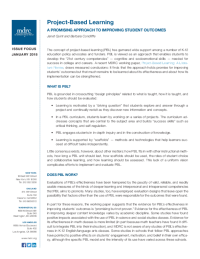Project-Based Learning: A Promising Approach to Improving Student Outcomes

The concept of project-based learning (PBL) has garnered wide support among a number of K-12 education policy advocates and funders. PBL is viewed as an approach that enables students to develop the “21st century competencies” — cognitive and socioemotional skills — needed for success in college and careers. A recent MDRC working paper, Project-Based Learning: A Literature Review, draws measured conclusions: It finds that the approach holds promise for improving students’ outcomes but that much remains to be learned about its effectiveness and about how its implementation can be strengthened.
WHAT IS PBL?
PBL is grounded in crosscutting “design principles” related to what is taught, how it is taught, and how students should be evaluated:
-
Learning is motivated by a “driving question” that students explore and answer through a project and continually revisit as they discover new information and concepts.
-
In a PBL curriculum, students learn by working on a series of projects. The curriculum addresses concepts that are central to the subject area and builds “success skills” such as critical thinking, and self-regulation.
-
PBL engages students in in-depth inquiry and in the construction of knowledge.
-
Learning is supported by “scaffolds” — methods and technologies that help learners succeed at difficult tasks independently.
Little consensus exists, however, about other matters: how PBL fits in with other instructional methods, how long a PBL unit should last, how scaffolds should be used, the roles of student choice and collaborative learning, and how learning should be assessed. This lack of a uniform vision complicates efforts to implement and evaluate PBL.
DOES PBL WORK?
Evaluations of PBL’s effectiveness have been hampered by the paucity of valid, reliable, and readily usable measures of the kinds of deeper learning and interpersonal and intrapersonal competencies that PBL aims to promote. Many studies, too, have employed evaluation designs that leave open the possibility that factors other than the use of PBL were responsible for the outcomes that were found.
In part for these reasons, the working paper suggests that the evidence for PBL’s effectiveness in improving students’ outcomes is “promising but not proven.” Evidence for the effectiveness of PBL in improving deeper content knowledge varies by academic discipline. Some studies have found positive impacts associated with the use of PBL in science and social studies classes. Evidence for its effectiveness in math classes is more limited (in part because math teachers have found it difficult to integrate PBL into their instruction), and MDRC is not aware of any studies of PBL’s effectiveness in K-12 English/language arts classes. Some studies in schools that follow PBL approaches have pointed to positive effects on students’ engagement, motivation, and belief in their own efficacy, although the specific PBL model and the intensity of its use have varied across these schools.
WHAT DOES IT TAKE TO IMPLEMENT PBL?
The working paper discusses the substantial challenges associated with implementing PBL —– related both to the role of individual teachers and to the environment in which they work. PBL requires teachers to modify their role (from directors to facilitators of learning) and to tolerate not only ambiguity but also more noise and movement in the classroom. Teachers must employ new classroom management skills and learn how best to scaffold the collective and individual learning of their students, using technology when appropriate. Above all, perhaps, they must believe that their students are fully capable of learning through this approach.
The working paper also reviews what is known about how district and school factors influence the adoption of PBL. It concludes that, given these challenges, professional development for teachers is likely to be essential to the successful implementation of PBL.
HOW CAN THE STUDY OF PBL MOVE FORWARD?
The working paper points to directions for advancing research on PBL’s design principles, effectiveness, and implementation. Among its recommendations:
-
It should be possible to translate PBL design principles into observable measures that set a PBL classroom apart from those that follow a more traditional approach.
-
More attention should be given to how student learning can better be assessed in PBL classrooms.
-
More rigorous evaluation methodologies are needed to determine whether PBL causes or is merely associated with the outcomes that are observed.
-
PBL’s effect on mastery of math and literacy skills needs more attention, as does its effectiveness for different groups of students.
-
Research should address the ways in which a school’s context (for example, the students it serves or school leadership support) influences the adoption and adaptation of PBL in the classroom.
-
Studies should assess the effectiveness of different models of professional development for increasing the quantity and quality of PBL implementation.
In summary, the new focus on higher-level thinking skills and socioemotional competencies seems well aligned with the goals of PBL. Further research would help policymakers and practitioners determine whether the promise of PBL can be realized, which PBL models are most effective, and how their use can be brought to scale. Lucas Education Research (LER) supported an earlier version of the working paper reviewed in this brief and is currently funding research projects that address many of these questions. For example, Nell K. Duke and colleagues’ current experimental evaluation of a social studies curriculum for second-grade students overcomes many of the methodological limitations of prior evaluations of PBL curricula and specifically addresses the question of whether a PBL curriculum improves students’ literacy skills. In addition, with funding from the National Science Foundation, Barbara Schneider and Joseph Krajcik, with partners in Finland from the University of Helsinki, are developing and testing project-based science curricula for students that align with the Next Generation Science Standards. The research study addresses some of the current limitations in the field regarding measures of student engagement.






